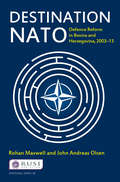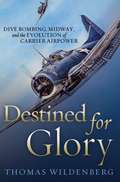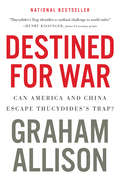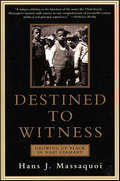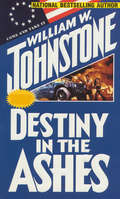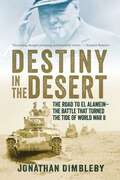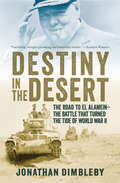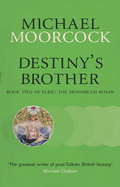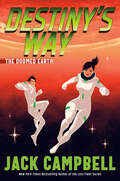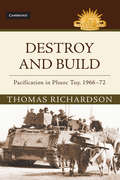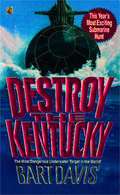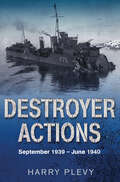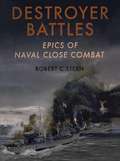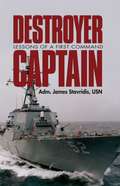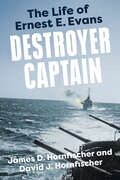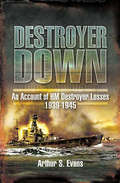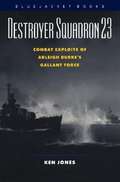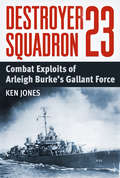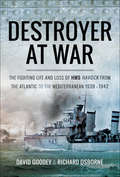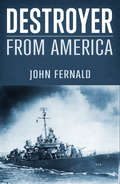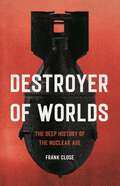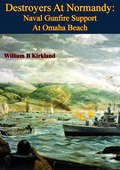- Table View
- List View
Destination Elsewhere: Displaced Persons and Their Quest to Leave Postwar Europe
by Ruth BalintIn this unique "history from below," Destination Elsewhere chronicles encounters between displaced persons in Europe and the Allied agencies who were tasked with caring for them after the Second World War. The struggle to define who was a displaced person and who was not was a subject of intense debate and deliberation among humanitarians, international law experts, immigration planners, and governments. What has not adequately been recognized is that displaced persons also actively participated in this emerging refugee conversation. Displaced persons endured war, displacement, and resettlement, but these experiences were not defined by passivity and speechlessness. Instead, they spoke back, creating a dialogue that in turn helped shape the modern idea of the refugee. As Ruth Balint shows, what made a good or convincing story at the time tells us much about the circulation of ideas about the war, the Holocaust, and the Jews. Those stories depict the emerging moral and legal distinction between economic migrants and political refugees. They tell us about the experiences of women and children in the face of new psychological and political interventions into the family. Stories from displaced persons also tell us something about the enduring myth of the new world for people who longed to leave the old. Balint focuses on those persons whose storytelling skills became a major strategy for survival and escape out of the displaced persons' camps and out of the Europe. Their stories are brought to life in Destination Elsewhere, alongside a new history of immigration, statelessness, and the institution of the postwar family.
Destination NATO: Defence Reform in Bosnia and Herzegovina, 2003–13 (Whitehall Papers)
by John Andreas Olsen Rohan MaxwellDefence reform has been a major component of Bosnia’s stabilisation and nation-building. Though true for many cases of post-conflict transition, it is especially so for Bosnia, which arguably has the most complex state structure in Europe. Ten years on from the start of Bosnia’s defence-reform process, Destination NATO records and reviews the Bosnian experience of defence reform. The monograph offers policy-makers, practitioners and academics knowledge of the specific case of Bosnia and Herzegovina, and makes these insights relevant to defence-reform efforts in other contexts. The research is based on original sources and an extensive set of interviews and talks with key individuals including ambassadors, ministers and civil servants, and other senior national and international actors, in addition to discussions with several hundred politicians at local levels, students and NGO representatives. The authors also use their first-hand knowledge and insights to complement the documentation, interviews and discussions.
Destined for Glory
by Thomas WildenbergOn 4 June 1942, three squadrons of U.S. Navy Dauntless dive bombers destroyed Japan's carrier force at Midway and changed the course of the Pacific war. As Wildenberg demonstrates in this book, the key ingredient to the Navy's success was the planning and training devoted to the tactic of dive bombing. Examining how political, economic, technical, and operational factors influenced the development of carrier airpower between 1925 and 1942, he shows why dive bombing became the Navy's weapon of choice. He also pays tribute to the select group of naval aviators who drove the evolution of carrier tactics. Although many books have been written about the Battle of Midway, this is the first to focus on how the Navy came to develop the one aerial weapon that proved to be the decisive instrument of victory
Destined for War: Can America and China Escape Thucydides's Trap?
by Graham AllisonCHINA AND THE UNITED STATES ARE HEADING TOWARD A WAR NEITHER WANTS. The reason is Thucydides’s Trap, a deadly pattern of structural stress that results when a rising power challenges a ruling one. This phenomenon is as old as history itself. About the Peloponnesian War that devastated ancient Greece, the historian Thucydides explained: “It was the rise of Athens and the fear that this instilled in Sparta that made war inevitable.” Over the past 500 years, these conditions have occurred sixteen times. War broke out in twelve of them. Today, as an unstoppable China approaches an immovable America and both Xi Jinping and Donald Trump promise to make their countries “great again,” the seventeenth case looks grim. Unless China is willing to scale back its ambitions or Washington can accept becoming number two in the Pacific, a trade conflict, cyberattack, or accident at sea could soon escalate into all-out war. In Destined for War, the eminent Harvard scholar Graham Allison explains why Thucydides’s Trap is the best lens for understanding U.S.-China relations in the twenty-first century. Through uncanny historical parallels and war scenarios, he shows how close we are to the unthinkable. Yet, stressing that war is not inevitable, Allison also reveals how clashing powers have kept the peace in the past — and what painful steps the United States and China must take to avoid disaster today.
Destined to Survive: A Dieppe Veteran's Story
by Jack A. Poolton Jayne Turvey PooltonPrivate Jack Poolton was among the Canadians landing at the disastrous raid on Dieppe. Fortunate to have survived, Jack was taken to a prisoner of war camp in Germany. In Destined to Survive: A Dieppe Veteran’s Story, Jack Poolton relates the story of his training, capture, and experiences in the POW camp. We follow Jack’s three escape attempts, and his subsequent punishment. And we share his elation when Jack and his fellow prisoners are liberated by American soldiers.Poolton and the other POWs never lost their desire to escape. Throughout the ordeal, Jack dreamed of one day celebrating the end of the war, and an allied victory. He eventually celebrated V-E Day in England.Written as a tribute to the fifty-fifth anniversary of the Dieppe Raid, Destined to Survive is an extraordinary contribution to Canadian military history. Poolton’s honest prose reveals the emotions of a man devoted to King and country, and determined to survive at all costs. The gripping account brings the reader to a new understanding about soldiers, prisoners, and war.
Destined to Witness: Growing Up Black In Nazi Germany
by Hans MassaquoiThis “extraordinary” memoir of a black man’s coming of age in Nazi Germany is “an entirely engaging story of accomplishment despite adversity.” —Washington Post Book WorldIn Destined to Witness, Hans Massaquoi has crafted a beautifully rendered memoir—an astonishing true tale of growing up black in Nazi Germany. The son of a prominent African and a German nurse, Hans remained behind with his mother when Hitler came to power, after his father returned to Liberia. Like other German boys, Hans went to school; like other German boys, he swiftly fell under the Fuhrer’s spell. So he was crushed to learn that, as a black child, he was ineligible for the Hitler Youth. His path to a secondary education and an eventual profession was blocked. He now lived in fear that, at any moment, he might hear the Gestapo banging on the door—or Allied bombs falling on his home. Ironic, moving, and deeply human, Massaquoi’s account of this lonely struggle for survival brims with courage and intelligence.“A cry against racism, a survivor’s tale, a wartime adventure, a coming of age story, and a powerful tribute to a mother’s love.”—New Orleans Times-Picayune“An incredible tale . . . Exceptional.” —Chicago Sun Times“Destined to Witness examines a roller coaster of racism from different cultures and continents.” —The New York Times Book Review“Here is a story rarely lived and even more rarely told. We need this book for a balanced picture of the Holocaust.” —Maya Angelou“A nuanced, startling memoir.” —Kirkus Reviews“An engaging story of a young man’s journey through hate, self-enlightenment, intrigue and romance.” —Ebony
Destiny in the Ashes (Ashes #33)
by William W. JohnstoneBen Raines and his army won a war on two fronts, bringing law, peace and prosperity to the Southern United States of America. But SUSA's northern northern neighbor and erstwhile enemy, the United States, is still in chaos. And when a ferocious invader attacks the soft and crippled nation, Raines has no choice but to act!Courageous warlord Abdullah El Farrar has risen up from the humiliated regions of the oil-rich Near East—unleashing a stunning attack against the once proud northern United States. No One in the Southern United States is surprised that USA cannot defend its own land. But with northern citizens defecting by thousands to El Farrar's forces, Raines can see the handwriting on the wall: his brave armies must go to war—to save their enemy from itself.
Destiny in the Desert: The Road to El Alamein: The Battle that Turned the Tide of World War II
by Jonathan DimbelbyThe definitive history of the battle of El Alamein?"The end of the beginning," as Churchill said?the bloody conflict that would change the course of World War II.It was the Allied victory at the Battle of El Alamein in November 1942 that inspired one of Churchill's most famous aphorisms: &“This is not the end, it is not even the beginning of the end, but it is, perhaps, the end of the beginning.&” In this thrilling historical account, Jonathan Dimbleby describes the political and strategic realities that lay behind the battle, charting the nail-biting months that led to the victory at El Alamein in November 1942. Drawing on official records and the personal insights of those involved, Dimbleby creates a vivid portrait of a struggle which for Churchill marked the turn of the tide?and which for the soldiers on the ground involved fighting and dying in a foreign land. 16 pages of B&W photographs
Destiny in the Desert: The Road to El Alamein: The Battle that Turned the Tide of World War II
by Jonathan DimblebyIt was the Allied victory at the Battle of El Alamein in November 1942 that inspired one of Churchill's most famous aphorisms: "This is not the end, it is not even the beginning of the end, but it is, perhaps, the end of the beginning." And yet the true significance of this iconic episode remains unrecognized.In this thrilling historical account, Jonathan Dimbleby describes the political and strategic realities that lay behind the battle, charting the nail-biting months that led to the victory at El Alamein in November 1942. It is a story of high drama, played out both in the war capitals of London, Washington, Berlin, Rome, and Moscow, and at the front, in the command posts and foxholes in the desert.Destiny in the Desert is about politicians and generals, diplomats, civil servants, and soldiers. It is about forceful characters and the tensions and rivalries between them.Drawing on official records and the personal insights of those involved at every level, Dimbleby creates a vivid portrait of a struggle which for Churchill marked the turn of the tide--and which for the soldiers on the ground involved fighting and dying in a foreign land.
Destiny's Brother: Book Two of Elric: The Moonbeam Roads
by Michael Moorcock'I am Oona, the shape-taker, Grafin von Bek, daughter of Oone the Dreamthief and Elric, Sorcerer Emperor of Melniboné'Ulric von Bek, now married to Oona, the Daughter of Dreams, has been abducted by a band of spectral natives, while travelling through Canada.Oona gives chase, en route to the Skrayling Oak which contains all realities, to brave the maelstrom of a mythic America - where malign forces try to pitch her against Elric, an aspect of the Eternal Champion and her father.Meanwhile, the captured Ulric finds himself once more in the multiverse where finally he is reunited with his alternate self, Elric, and his wife, Oona. There, the three of them must take arms against an impossible enemy, bent on destroying the Skrayling Oak. For if the tree falls, so too does the multiverse ...
Destiny's Way (The Doomed Earth Duology)
by Jack CampbellLieutenant Selene Genji is hurled into the past to try and save a world that doesn&’t want her in this action-packed adventure from New York Times bestselling author Jack Campbell.Earth was destroyed on June 12, 2180. Lieutenant Selene Genji watched it happen. And only she can prevent it. Thrown forty years into the past, into a time before the Universal War began, Genji can only guess what to do to change the events that led to the death of all humanity. She has no way of knowing the long-term impacts of her actions and can only depend on her instincts. But many of the people Genji&’s trying to save want her dead. Her creation was an experiment: a fusing of human and alien DNA. To them, she&’s a monster who can&’t be trusted, a tool of the aliens who have just made first contact. Fortunately, she has an unshakable ally in Lieutenant Kayl Owen, who has risked everything to help her mission. Declared a traitor to humanity by Earth Guard, Owen is determined to help Genji save the Earth. Even if he dies trying.
Destroy Me
by Shana VanterpoolBach lives his life with honesty and without restraints, happy to be known as a sexy as all hell, unapologetic asshole. When he drinks, he drinks hard. When he wants a woman, he makes sure she knows it. When he opens his mouth, it's either to piss someone off or to turn someone on. You can normally find him with one hand on a bottle and one hand on a woman, trying to forget his past. Harley Evans is twenty-one-year-old year old college student. She's a good girl who fell hard for Dylan, who'd promised her forever. But Dylan, Bach's best buddy, lied. He enlisted in the Army, crushing Harley with equal parts anger and sadness. She'd already lost her father to that choice. Heartbroken, she falls back into depression. Stuck in Crystal Gulf all summer with little to do, Harley needs a distraction. Enter Bach, sexy as f*#ck distraction, ready and willing. Dylan's not all bad though. Before he left, he asked Bach to watch out for Harley, knowing she'd never go for a guy like Bach. She's too good for him. Too good for anyone. But Dylan was wrong. He never should have left them together. Bach is there to pick up the pieces Dylan left behind. Soon pieces aren't enough. He wants more, needs more Harley. DESTROY ME is dark, sexy, heartbreaking, and intoxicating.
Destroy and Build: Pacification in Phuoc Thuy, 1966–72 (Australian Army History Series)
by Thomas RichardsonIn 2002, Governor General Michael Jeffrey stated that 'we Australians had everything under control in PhuocTuy Province'. This referred not only to military control, but to the policy of 'pacification' employed by the Republic of Vietnam and external 'Free World' allies such as the US and Australia. In the hopes of stemming the tide of Communism, pacification aimed to win the allegiance of the populace through political, economic and social reform. In this new work, Thomas Richardson explores the 1st Australian Task Force's (1ATF) implementation of this policy in Phuoc Tuy between 1966 and 1972. Using material from US and Australian archives, as well as newly translated Vietnamese histories, Destroy and Build: Pacification in Phuoc Tuy, 1966–1972 challenges the accepted historiography of the Western forces' fight against insurgency in Vietnam. Challenges the accepted historiography of the fight against insurgency in Vietnam Discusses the policy of pacification on its own merits, rather than by its impact on Western forces Introduces readers to a commonly overlooked aspect of the war in Vietnam.
Destroy the Kentucky
by Bart DavisSpies, soldiers and true believers -- in the hunt for the Kentucky. This year's most exciting submarine hunt for the most dangerous underwater target in the world. PETER MacKENZIE: In the USS Seawolf he had out-dueled the Soviet's best submarine. But a tragic accident wrecked his self-confidence. Now he's back in foreign waters in command of a Soviet submarine--and a top-secret hunt for the stolen U.S. mini-sub ... RAZA: Brought to Moscow for special training, he became a colonel in the Spetsnatz Special Forces and head of a radical group in Turkmenistan, his native Arab land. Then he masterminded the taking of the Kentucky--and turned it against his former masters . . . JUSTINE SEGURRA: She was painfully familiar with the ways of revolution. Now the CIA agent and wife of Captain MacKenzie is living and riding with hard, committed desert men--searching for the Kentucky's missing nuclear payload ... KEMAL: He is the charismatic leader of the Karadeen and the grandson of the Mahdi--holy man--imprisoned by the Soviets. The Russians have told him that the recovery of the hijacked missiles will mean freedom for the Mahdi, but he has his own plans for his proud people ...
Destroyer Actions: September 1939 - June 1940
by Harry PlevyUsing eye-witness accounts of those who participated, Destroyer Actions focuses on the human side of naval operations during the first eight months of the Second World War. Lucid treatment of the political, strategic and tactical background to naval operations allows the reader to understand the pivotal role played by the destroyer during the so called ‘Phoney War’ period.
Destroyer Battles: Epics of Naval Close Combat
by Robert C. StemFast, manoeuvrable and heavily armed, destroyers were the most aggressive surface warships of the twentieth century. Although originally conceived as a defensive screen to protect the main battlefleet from torpedo attack, the gamekeeper soon turned poacher, and became primarily a weapon of offence. As such they were involved in many hard-fought battles, using both torpedoes and guns, especially with enemy vessels of the same kind. This book recounts some of the most significant, spectacular or unusual actions in the history of destroyer warfare, from the first employment of torpedo craft during the Russo-Japanese War to the recent terrorist attack on USS Cole. With individual chapters devoted to each incident, the book may be read as a series of dramatic narratives, but each reflects a development in the tactics or technology, so taken as a whole the book amounts to a complete history of the destroyer from an unusual and previously neglected angle.
Destroyer Captain
by James StavridisThis memoir of James Stavridis' two years in command of the destroyer USS Barry (DDG-52) reveals the human side of what it is like to be in charge of a warship for the first time and in the midst of international crisis. From Haiti to the Balkans to the Arabian Gulf, the Barry was involved in operations throughout the world during his 1993-1995 tour. Drawing on daily journals he kept for the entire period, the author reveals the complex nature of those deployments in a 'real time' context and describes life on board the Barry and liberty ashore for sailors and officers alike.With all the joy, doubt, self-examination, hope, and fear of a first command, he offers an honest examination of his experience from the bridge to help readers grasp the true nature of command at sea. The window he provides into the personal lives of the crew illuminates not only their hard work in a ship that spent more than 70 percent of its time underway, but also the sacrifices of their families ashore. Stavridis credits his able crew for the many awards the Barry won while he was captain, including the Battenberg Cup for top ship in the Atlantic Fleet. Naval aficionados who like seagoing fiction will be attracted to the book, as will those fascinated by life at sea. Officers from all the services, especially surface warfare naval officers aspiring to command, will find these lessons of a first command by one of the Navy's most respected admirals both entertaining and instructive.
Destroyer Captain: The Life of Ernest E. Evans (American War Heroes)
by James D. Hornfischer David J. HornfischerFrom James D. Hornfischer, New York Times bestselling author of The Last Stand of the Tin Can Soldiers, a riveting account of the life of WWII hero Commander Ernest E. Evans and his heroics and sacrifice during the Leyte Gulf Battle of Samar. For the first time ever, acclaimed naval historian James D. Hornfischer, &“the dean of World War II naval history," writing with his son David J. Hornfischer, explores Capt. E. Evans&’s incredible story, from his humble upbringing as a child of a Cherokee and Creek family in Pawnee, Oklahoma, and his graduation from the Naval Academy in 1931, to his service on fighting ships during the Pacific War and his selfless bravery and cool command during a valiant faceoff with the pride of the Japanese Navy. Interspersed with impeccable research, interviews with men who fought alongside Capt. E. Evans, and thrilling anecdotes about United States Navy experiences during WWII, Destroyer Captain provides insight into an incredible man who spent his life beating the odds through courage, ability, and sheer determination. Never were these attributes better on display than on the morning of October 25, 1944, when, in the waters off Samar, a small flotilla of US Navy ships encountered a Japanese fleet superior in both vessels and firepower. Aboard the USS Johnston, Capt. Ernest E. Evans seized the moment, ordering his destroyer to steam forward and attack. Heavily outgunned, Evans and his sailors fired torpedo after torpedo, all the while maneuvering to dodge enemy shells, as two other American destroyers joined the fight. It was a valiant last stand for Capt. E. Evans, one of the toughest warriors in the Navy, but thanks to his bravery and steadiness under fire, these dogged Americans routed one of the most powerful naval forces that Tokyo had ever put to sea. A remarkable story of patriotism and courageousness, Destroyer Captain honors a singular American hero whose name shall never be forgotten.
Destroyer Down: An Account of HM Destroyer Losses, 1939–1945
by Arthur EvansThe author of Beneath the Waves provides a thorough history of the sinkings of Britain&’s destroyer warships during World War II. His Majesty&’s destroyers had a long and costly war. Some eight thousand destroyer men did not survive. At the height of the war the Royal navy was commissioning four new vessels a month, which was only sufficient to replace those which had been sunk or severely damaged. This outstanding book contains the details of the majority of the sinkings that occurred throughout World War II and includes many firsthand accounts from the officers and crew involved.
Destroyer Squadron 23
by Ken JonesCalled one of the most inspiring stories to come out of World War II when first published in 1959, this epic account of Arleigh Burke's legendary Destroyer Squadron 23 is much more than a story of ships and their tactical deployment. It is a story of men in action--some four thousand of them--and how they lived and fought as a magnificent combat team.Ken Jones not only records their heroic deeds but helps explain what prompted those deeds, including the leadership qualities that fired the men into action. In doing so he brings to life the outfit's fighting spirit--that mysterious combination of qualities inspired by great leaders that wins battles--and the man who led them. Commodore Arleigh Burke was the right man at the right place at the right time; his leadership fused the squadron into a superb combat organization.This book offers a vivid account of the fighting in the South Pacific during one of the most crucial periods of the war. In authentic, minute-by-minute detail drawn from once-secret documents, Jones describes the battles of Tassafaronga, Savo Island, Empress Augusta Bay, and Cape St. George. But the focus throughout is on the men as they meet the test of battle with a common bravery as staunch as any in the Navy's annals. No squadron in any navy is said to have won more battle honors in less time than the Fighting Twenty-third.
Destroyer Squadron 23: Combat Exploits of Arleigh Burke's Gallant Force
by John Kenneth JonesDestroyer Squadron 23, first published in 1959, is the epic account of Commodore Arleigh Burke and the men and ships under his command in the South Pacific in World War II. Burke’s leadership skills and innovative tactics, described in detail in the book, proved crucial to the U.S. defeat of the Japanese navy in the Pacific. Included are 10 pages of maps.
Destroyer at War: The Fighting Life and Loss of HMS Havock from the Atlantic to the Mediterranean 1939–42
by Richard Osborne David GoodeyIt was headline news on 8 April 1942: One of the Navys most famous destroyers, a ship which survived bombs, torpedoes and full scale battles, has been wrecked. That destroyer was HMS Havock, described in another newspaper as Britains No 2 Destroyer of this war second only in fame and glory to the Cossack.Havock had earned her reputation guarding the convoys across the Atlantic in 1939 and at Narvik in the abortive bid to stave off the German occupation of Norway in 1940. Havock was then transferred to the Mediterranean, fighting at the Battle of Cape Spada in 1940 and in 1941 at the Battle of Matapan and in the evacuations of Greece and Crete.Havocks duties in the Med continued, escorting the convoys to the besieged island of Malta and the equally beleaguered garrison at Tobruk. Then in the Battle of Sirte in 1942 Havock was badly damaged and she limped into Malta for repairs. There she was heavy bombed and when Havock made a bid to reach Gibraltar, she was wrecked off Cape Bon. Her crew was captured and imprisoned in the infamous Laghouat internment camp.The authors have tracked down fifty of the surviving crew and from interviews have been able to compile one of the most detailed, and certainly one of the most dramatic, histories of a destroyer during the Second World War. Destroyer at War tells the story of the battles and operations of a famous ship, and its sad destruction, through newspaper reports, official documents, and the words of the men who sailed and fought in HMS Havock as she earned an astonishing eleven battle honors in her brief but glorious career.
Destroyer from America
by John B. FernaldDestroyer from America, first published in 1942, is a fictionalized account of life aboard a naval destroyer on convoy duty in the North Atlantic during the early days of World War II. Although not filled with combat scenes, the book paints an accurate picture of life aboard a destroyer as the men deal with the inclement weather, lost ships, boredom, missed loved ones, and an encounter with a German submarine. Author John B. Fernald served in the Royal Navy Volunteer Reserve during the war, aboard the HMS Newmarket, formerly the USS Robinson of the U.S. Navy, one of the four-stacker destroyers provided to the British before America's entry into the war.
Destroyer of Worlds: The Deep History of the Nuclear Age
by Frank CloseThe thrilling and terrifying seventy-year story—"kinetic, dramatic, and compulsively readable" (Patchen Barss)—of the physicists that deciphered the atom and created the hydrogen bomb Although Henri Becquerel didn&’t know it at the time, he changed history in 1896 when he left photographic plates and some uranium rocks in a drawer. The rocks emitted something that exposed the plates: it was the first documented evidence of spontaneous radioactivity. So began one of the most exciting and consequential efforts humans have ever undertaken. As Frank Close recounts in Destroyer of Worlds, scientists confronting Becquerel&’s discovery had three questions: What was this phenomenon? Could it be a source of unlimited power? And (alas), could it be a weapon? Answering them was an epic journey of discovery, with Ernest Rutherford, Enrico Fermi, Irene Joliot-Curie, and many others jockeying to decipher the dance of particles in a decaying atom. And it was a terrifying journey as well, as Edward Teller and others pressed on from creating atom bombs to hydrogen bombs so powerful that they could destroy all life on earth. The deep history of the nuclear age has never before been recounted so vividly. Centered on an extraordinary cast of characters, Destroyer of Worlds charts the course of nuclear physics from simple curiosity to potential Armageddon.
Destroyers At Normandy: Naval Gunfire Support At Omaha Beach [Illustrated Edition]
by William B. Kirkland John C. ReillyIncludes numerous maps and illustrations.This monograph provides first-hand accounts of Destroyer Squadron 18 during this critical battle upon which so much of the success of our campaign in Europe would depend. Their experience at Omaha Beach can be looked upon as typical of most U.S. warships engaged at Normandy. On the other hand, from the author's research it appears evident that this destroyer squadron, with their British counterparts, may have had a more pivotal influence on the breakout from the beachhead and the success of the subsequent campaign than was heretofore realized. Its contributions certainly provide a basis for discussion among veterans and research by historians, as well as a solid, professional account of naval action in support of the Normandy landings.

